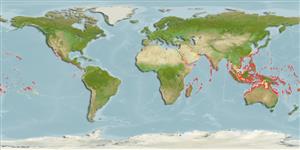Common names from other countries
>
Eupercaria/misc (Various families in series Eupercaria) >
Scaridae (Parrotfishes) > Scarinae
Etymology: Scarus: Greek, skaros = a fish described by anciente writers as a parrot fish; 1601 (Ref. 45335).
More on author: Bleeker.
Environment: milieu / climate zone / depth range / distribution range
Ekologi
marina revassocierade; djupintervall 1 - 36 m (Ref. 5227). Tropical; 30°N - 27°S
Indo-Pacific: East Africa south to Durban, South Africa (Ref. 5490) and east to the Tuamoto Islands, north to the Ryukyu and Hawaiian islands, south to Shark Bay, Western Australia and the southern Great Barrier Reef. Excluding Rapa and Austral Islands (Ref. 86689). Eastern Pacific: Gulf of California to the Galapagos Islands (Ref. 5227).
Size / Vikt / Age
Maturity: Lm ? range ? - ? cm
Max length : 70.0 cm TL hane/ej könsbestämd; (Ref. 2334); rapporterad maxålder: 20 år (Ref. 42001)
Taggstrålar i ryggfenan (totalt) : 9; Mjukstrålar i ryggfenan (totalt) : 10; Taggstrålar i analfenan: 3; Mjukstrålar i analfenan: 9. This species is distinguished by the following characters: 6 median predorsal scales; 3 scale rows on cheek 1(5-7), 2(5-7), 3(1-3); pectoral-fin rays 14-16 (usually 15); conical teeth on side, 0-1 on upper dental plate of female, 1-3 on terminal male; lips mainly covering half or more of dental plates; terminal male with angular snout profile; caudal fin slightly emarginate in female, lunate with prolonged lobes in terminal male. Colour of male with distinct bicolour pattern, brownish to dark green on head and anterior body and lighter green on posterior portion; female reddish brown to grey with small black spots and irregular black lines and white flakes on body (Ref. 9793, 90102).
Occurs solitary or in pairs in seaward reefs (Ref. 90102). Usually over rocky or coral substrates, at boulder-strewn slopes at the base of high-island cliffs where it may occur in large schools. Large adult usually on upper parts of deep slopes, but seen to about 35 m depth (Ref. 48636). Benthopelagic (Ref. 58302). Feeds on benthic algae (Ref. 30573). A protogynous hermaphrodite (Ref. 55367). An uncommon species (Ref. 9338).
Life cycle and mating behavior
Maturities | Reproduktion | Spawnings | Egg(s) | Fecundities | Larver
Oviparous, distinct pairing during breeding (Ref. 205). Sex change occurs at 37.4 cm TL and 13 years of age (Ref. 55367).
Randall, J.E., G.R. Allen and R.C. Steene, 1990. Fishes of the Great Barrier Reef and Coral Sea. University of Hawaii Press, Honolulu, Hawaii. 506 p. (Ref. 2334)
IUCN Red List Status (Ref. 130435)
CITES (Ref. 128078)
Not Evaluated
Threat to humans
Harmless
Human uses
Fiskeri: kommersiell; Akvarium: Kommersiell
Verktyg
Special reports
Download XML
Internet-källor
Estimates based on models
Preferred temperature (Ref.
115969): 24.9 - 29.3, mean 28.3 (based on 3457 cells).
Phylogenetic diversity index (Ref.
82804): PD
50 = 0.5000 [Uniqueness, from 0.5 = low to 2.0 = high].
Bayesian length-weight: a=0.01288 (0.00846 - 0.01961), b=3.10 (2.98 - 3.22), in cm Total Length, based on LWR estimates for this species & Genus-body shape (Ref.
93245).
Trofisk nivå (Ref.
69278): 2.0 ±0.00 se; based on food items.
Resiliens (Ref.
120179): Mellan, lägsta populationsfördubblingstid 1,4-4,4 år (tmax=20; K >0.30).
Fishing Vulnerability (Ref.
59153): Low to moderate vulnerability (30 of 100).
